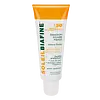What's inside
What's inside
 Key Ingredients
Key Ingredients

No key ingredients
 Benefits
Benefits

 Concerns
Concerns

 Ingredients Side-by-side
Ingredients Side-by-side

Water
Skin ConditioningParaffinum Liquidum
EmollientStearic Acid
CleansingGlyceryl Stearate
EmollientTriethanolamine
BufferingCera Alba
EmollientCetyl Palmitate
EmollientButyrospermum Parkii Butter
Skin ConditioningSteareth-10
EmulsifyingPolyacrylamide
C13-14 Isoparaffin
EmollientLaureth-7
EmulsifyingPropylene Glycol
HumectantHydrolyzed Soy Protein
HumectantAloe Barbadensis Sprout
Humectant1,2-Hexanediol
Skin ConditioningCaprylyl Glycol
EmollientTropolone
Skin ConditioningParfum
MaskingWater, Paraffinum Liquidum, Stearic Acid, Glyceryl Stearate, Triethanolamine, Cera Alba, Cetyl Palmitate, Butyrospermum Parkii Butter, Steareth-10, Polyacrylamide, C13-14 Isoparaffin, Laureth-7, Propylene Glycol, Hydrolyzed Soy Protein, Aloe Barbadensis Sprout, 1,2-Hexanediol, Caprylyl Glycol, Tropolone, Parfum
Water
Skin ConditioningOctocrylene
UV AbsorberC12-15 Alkyl Benzoate
AntimicrobialDimethicone
EmollientEthylhexyl Salicylate
UV AbsorberButyl Methoxydibenzoylmethane
UV AbsorberSilica
AbrasiveButylene Glycol
HumectantMethyl Methacrylate Crosspolymer
Bis-Ethylhexyloxyphenol Methoxyphenyl Triazine
Skin ConditioningGlycerin
HumectantStyrene/Acrylates Copolymer
Methylene Bis-Benzotriazolyl Tetramethylbutylphenol
UV FilterChrysanthemum Parthenium Flower Extract
Skin ConditioningLecithin
EmollientTocopheryl Acetate
AntioxidantCaprylyl Glycol
EmollientPropylene Glycol
HumectantGlyceryl Stearate
EmollientPEG-100 Stearate
Potassium Cetyl Phosphate
EmulsifyingLinseed Acid
CleansingPEG-8 Laurate
EmulsifyingDecyl Glucoside
CleansingSodium Dodecylbenzenesulfonate
CleansingAcrylates Copolymer
Xanthan Gum
EmulsifyingCetearyl Alcohol
EmollientDimethicone Crosspolymer
Emulsion StabilisingSodium Acrylates Copolymer
Caprylhydroxamic Acid
Disodium EDTA
Phenoxyethanol
PreservativeParfum
MaskingWater, Octocrylene, C12-15 Alkyl Benzoate, Dimethicone, Ethylhexyl Salicylate, Butyl Methoxydibenzoylmethane, Silica, Butylene Glycol, Methyl Methacrylate Crosspolymer, Bis-Ethylhexyloxyphenol Methoxyphenyl Triazine, Glycerin, Styrene/Acrylates Copolymer, Methylene Bis-Benzotriazolyl Tetramethylbutylphenol, Chrysanthemum Parthenium Flower Extract, Lecithin, Tocopheryl Acetate, Caprylyl Glycol, Propylene Glycol, Glyceryl Stearate, PEG-100 Stearate, Potassium Cetyl Phosphate, Linseed Acid, PEG-8 Laurate, Decyl Glucoside, Sodium Dodecylbenzenesulfonate, Acrylates Copolymer, Xanthan Gum, Cetearyl Alcohol, Dimethicone Crosspolymer, Sodium Acrylates Copolymer, Caprylhydroxamic Acid, Disodium EDTA, Phenoxyethanol, Parfum
 Reviews
Reviews

Ingredients Explained
These ingredients are found in both products.
Ingredients higher up in an ingredient list are typically present in a larger amount.
Caprylyl Glycol is a humectant and emollient, meaning it attracts and preserves moisture.
It is a common ingredient in many products, especially those designed to hydrate skin. The primary benefits are retaining moisture, skin softening, and promoting a healthy skin barrier.
Though Caprylyl Glycol is an alcohol derived from fatty acids, it is not the kind that can dry out skin.
This ingredient is also used as a preservative to extend the life of products. It has slight antimicrobial properties.
Learn more about Caprylyl GlycolGlyceryl Stearate is a mix of glycerin and stearic acid.
It is used to stabilize the mixing of water and oil ingredients. By preventing these ingredients from separating, it can help elongate shelf life. It can also help thicken the product's texture.
As an emollient, it helps soften skin and supports barrier-replenishing ingredients.
In cosmetics, Glyceryl Stearate is often made from vegetable oils or synthetically produced.
This ingredient may not be fungal-acne safe
Fun fact: The human body also creates Glyceryl Stearate naturally.
Learn more about Glyceryl StearateParfum is a catch-all term for an ingredient or more that is used to give a scent to products.
Also called "fragrance", this ingredient can be a blend of hundreds of chemicals or plant oils. This means every product with "fragrance" or "parfum" in the ingredients list is a different mixture.
For instance, Habanolide is a proprietary trade name for a specific aroma chemical. When used as a fragrance ingredient in cosmetics, most aroma chemicals fall under the broad labeling category of “FRAGRANCE” or “PARFUM” according to EU and US regulations.
The term 'parfum' or 'fragrance' is not regulated in many countries. In many cases, it is up to the brand to define this term.
For instance, many brands choose to label themselves as "fragrance-free" because they are not using synthetic fragrances. However, their products may still contain ingredients such as essential oils that are considered a fragrance by INCI standards.
One example is Calendula flower extract. Calendula is an essential oil that still imparts a scent or 'fragrance'.
Depending on the blend, the ingredients in the mixture can cause allergies and sensitivities on the skin. Some ingredients that are known EU allergens include linalool and citronellol.
Parfum can also be used to mask or cover an unpleasant scent.
The bottom line is: not all fragrances/parfum/ingredients are created equally. If you are worried about fragrances, we recommend taking a closer look at an ingredient. And of course, we always recommend speaking with a professional.
Learn more about ParfumPropylene Glycol is an odorless, colorless liquid. As a humectant, it helps skin retain moisture. It also aids in delivering active ingredients.
Another role of this ingredient is preventing a product from melting or freezing. Propylene glycol also adds antimicrobrial properties to a product, elongating product lifespan.
This ingredient is considered an organic alcohol and commonly added into both cosmetics and foods.
Those with sensitive skin or conditions may develop a rash when using this ingredient.
Learn more about Propylene GlycolWater. It's the most common cosmetic ingredient of all. You'll usually see it at the top of ingredient lists, meaning that it makes up the largest part of the product.
So why is it so popular? Water most often acts as a solvent - this means that it helps dissolve other ingredients into the formulation.
You'll also recognize water as that liquid we all need to stay alive. If you see this, drink a glass of water. Stay hydrated!
Learn more about Water